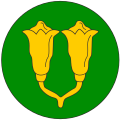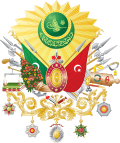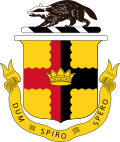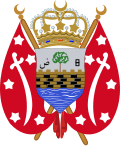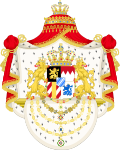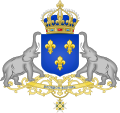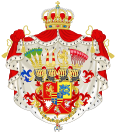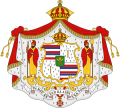热门问题
时间线
聊天
视角
前統治家族首領列表
維基媒體列表條目 来自维基百科,自由的百科全书
Remove ads
現有王位覬覦者列表是一個理論上有權「宣稱」或「想要」擁有王位的人物列表。值得注意的是:其中有的王位繼承者(或其王室成員後代)儘管實際上並沒有正式宣稱或已放棄繼承權,但按照過去法律「理論上」依然被視為可能繼任者。
此條目翻譯品質不佳。 |
非洲
Remove ads
美洲
Remove ads
亞洲
Remove ads
尼泊爾國內的一眾自治王國被聯邦政府於2008年10月7日廢除。自從rajas Gopendra Bahadur Shah 和 Prakash Bikram Shah 在2003年去世以來,Salyan District, 尼泊爾和Jajarkot的王座便保持空位至今[64][65]。
Remove ads
Remove ads
歐洲
Remove ads
太平洋
Remove ads
參見
註釋
- Fuad II previously reigned as King of Egypt and the Sudan during his infancy, from 1952年7月26日 until the monarchy's official abolition in 1953. He reigned in absentia, and under a regent.[4]
- According to the 1955 Constitution,[8] the Emperor designated his successor from members of his own family, with the rule of primogeniture preferred, but not necessarily followed. Candidates for the succession must be descendants of the Solomonic dynasty, in the male or female line. They must also be practising members of the Ethiopian Orthodox Church, and their candidature must be approved by the Imperial Crown Council. If the Emperor has no direct descendants, or if the Crown Prince is unable to perform his dynastic duties, the Crown Council selects the successor from amongst the members of the Solomonic dynasty.[7]
- During the civil war period beginning in 1669, the line of succession was disputed between two lines of descendants of Afonso I: the Kinlaza and the Kimpanzu.[10] Under Pedro IV (1695–1718), who restored unity to the kingdom in 1709, it was established that the Manikongo was to be elected by a council of six, and that succession would rotate between the two lineages. This system functioned sporadically, with considerable fighting, until the kingship was extinguished by the Portuguese in 1914.[11]
- The current line of succession to the Mexican throne is descended from the Houses of Iturbide and Habsburg, which respectively ruled the First (1822–1823) and Second (1864–1867) Empires of Mexico. Succession in the Habsburg line passed to the Iturbide family through Emperor Maximilian I's formal adoption of Agustín de Iturbide y Green and Salvador de Iturbide y Marzán, two grandsons of Emperor Agustín I.[27][28]
- Also known as the Alaungpaya dynasty.
- The House of Champasakti is Khun Lo dynasty of Laos 的分支。
- House of Bagrationi 的分支。 During the partition of the kingdom in the 15th Century, the Bagratid dynasty split into two main lineages: the Mukhrani line of Kartli, and the Gruzinsky line of Kakheti. It is between these two lineages that the leadership of the Royal House of Georgia is now disputed.
- Alternatively known as Thibaw, or officially as Dutawadi.
- Sao Oo Kya was imprisoned by the Burmese military regime in 2005.
- Rezā, eldest son of the last reigning shah, was Crown Prince of Iran from birth, on 1960年10月31日, until the monarchy was deposed in 1979.
- The Nayakar dynasty of Kandy was descended from the Nayaks of Madurai, who were of Telugu origin.
- Alternatively written as Kyaingtong or Keng Tung.
- The House of Yi consists of the descendants of the Joseon dynasty.
- Yi Won was chosen as the next head of the Imperial Household, with the title of Hereditary Prince Imperial of Korea, by a majority of its organised members following the death of the last head of the dynasty, Yi Gu, in 2005. Won was adopted as Gu's son after the elder's death, but the legality of the adoption is disputed.
- After the monarchy was deposed in 1975, the senior members of the royal family were imprisoned by the military. The deaths of the former King, Queen, and Crown Prince were confirmed by the Lao authorities on 1989年12月17日. The dates of actual death were not released, but the current heir, who is the eldest son of the late Crown Prince, escaped imprisonment and arrived in Thailand on 1981年8月3日. He was confirmed as the successor to his grandfather by the Royal Council in Exile on 1997年9月19日.
- Jampal Namdol Chökyi Gyaltsen was recognised as the 9th Jebtsundamba Khutuktu by the Tibetan government in 1936. He was publicly proclaimed as such by the current Dalai Lama in 1990, and was formally "enthroned" in 1999. His predecessors were the spiritual leaders of the Gelug branch of Tibetan Buddhism in Mongolia. The 8th Jebtsundamba Khutuktu was enthroned as Khan of Mongolia upon the country's independence from China in 1911. After his death in 1924, the installation of any further Khutuktus was forbidden by the republican government.
- Succession is neither hereditary nor elective, instead being based on theocratic laws.
- Sao Hso Hom reigned as 詔法 from 1947年7月19日, until the national coup d'état deposed him in 1962.
- The state of Sulu was abolished under the Carpenter Agreement of 1915. It was restored as a traditional polity in 1962. The sultan currently recognised by the government is listed under constituent monarchs.
- House of Sulu 的分支。 The royal family of Sulu is a Tausūg dynasty.
- Gyanendra reigned as King of Nepal between 1950年11月7日 and 1951年1月8日, and again from 2001年6月4日 until the monarchy was abolished in 2008.
- Members of the Shah dynasty of Nepal are descended from the Parmar clan of Rajputs from the former state of Narsinghgarh in modern India.
- Succession to the throne, whilst hereditary, is also subject to confirmation from the reigning King of Nepal.
- Prakash reigned as raja from 2002年11月13日 until 2008, when the constituent monarchies of Nepal were abolished.
- Jigme自1964年至2008年自治王國被廢除之時在位。
- The surname "Bista" was adopted by the last reigning raja and his family.
- A Crown colony of Great Britain from 1857, the Cocos Islands were granted in perpetuity to the Clunies-Ross family by Queen Victoria in 1886.[106] Its resulting self-proclaimed monarchy, however, was not recognised by the British government. It disbanded in 1978, when John Cecil Clunies-Ross relinquished his official authority as governor.[107]
- The House of Kawānanakoa was a collateral line of succession of the reigning Kalākaua dynasty.[110] The last queen, Liliʻuokalani, not having had any issue of her own, adopted and appointed the head of the Kawānanakoa as heir apparent.[111] The House of Kawānanakoa are historically recognised as the presumptive heirs to the throne should the monarchy be revived. Because of an early succession dispute within the family, there are currently two claimants from this household.
- Noa Kalokuokamaile DeGuair is a descendant of the House of Kalokuokamaile, which was a collateral line of succession of the Kamehameha dynasty, the first line of Hawaiʻian kings. It became extinct in the male line during the time of the monarchy, and now survives through the female line as the House of Laʻanui.[113] The current descendants also belong to the Wilcox lineage of English and Italian descent. His right to make a claim on the throne is disputed.[114]
- The House of Laʻanui consists of maternal descendants of the House of Kalokuokamaile,[113] the seniormost branch of the chiefly House of Keōua Nui.[115] It descends from the eldest half-brother of Hawaiʻi's first king, Kamehameha the Great, who united the petty chiefdoms of the Hawaiʻian Islands under the Kamehameha dynasty in 1810. When the male heirs of this lineage died out in 1872, it was replaced eventually by the Kawānanakoa dynasty.[116]
參考文獻
延伸閱讀
Wikiwand - on
Seamless Wikipedia browsing. On steroids.
Remove ads








